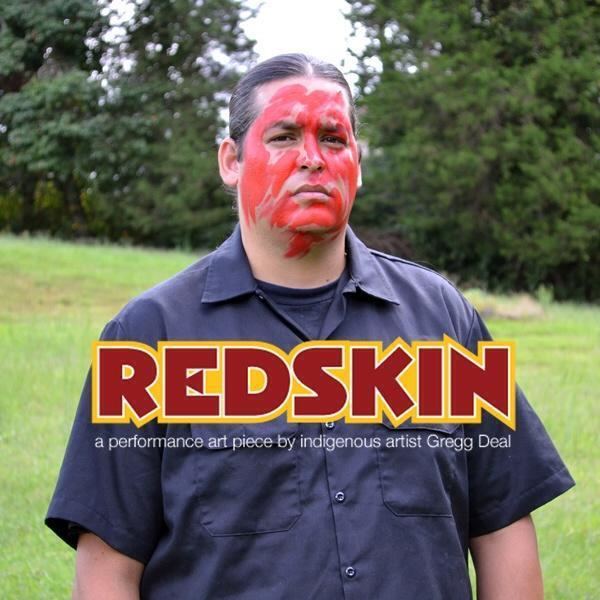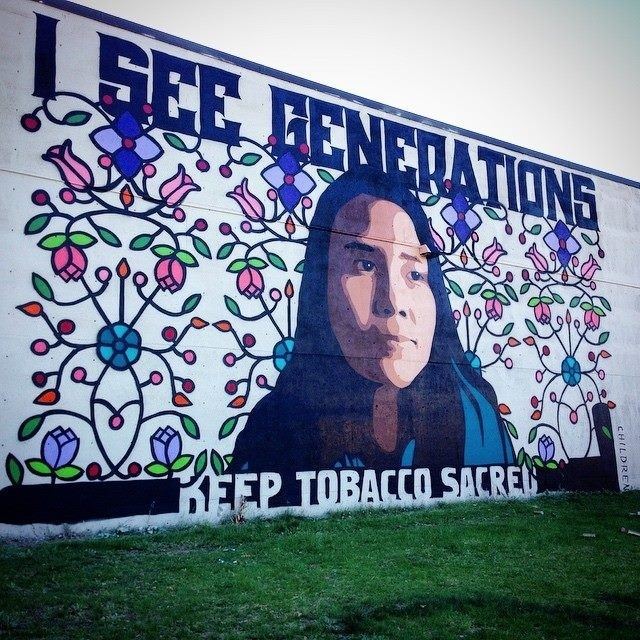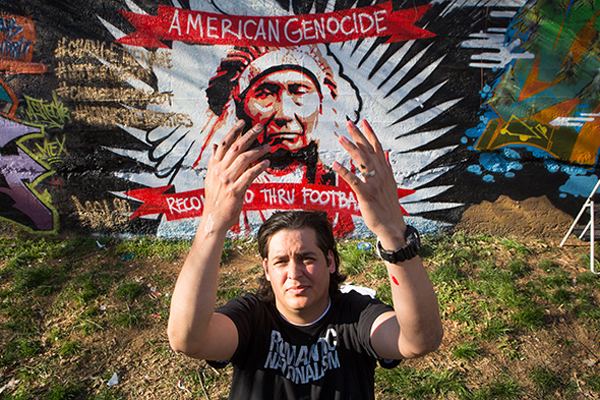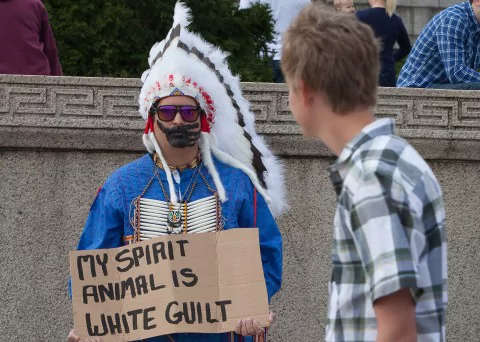Spouse(s) Megan Deal | ||
 | ||
Born 1975 ( 1975 ) Nationality Pyramid Lake Paiute, American Known for Performance, Street Art, Painting Notable work The Last American Indian On Earth, White Indian, American Genocide Reconciled Thru Football | ||
Gregg deal heritage i ve been indian my whole life
Gregg Deal is a husband, a father, an artist, an activist, and a member of the Pyramid Lake Paiute Tribe. His work deals mostly with Indigenous identity, decolonization, pop-culture, race relations, historical consideration and stereotype. He is best known for his performance and street art and his involvement with the movement to change the name of the Washington NFL team.
Contents
- Gregg deal heritage i ve been indian my whole life
- Arts district gregg deal
- Biography
- Career Artistic Themes
- Native Arts Artist In Residence at DAM
- Artwork
- Painting
- Street Art Murals
- Performance Art
- The Last American Indian On Earth
- Redskin
- Ethnographic Zoo
- White Indian
- Conceptual Art
- Print Media Graphic Design
- Spoken Word
- Activism
- Inspiration Influences
- References

Arts district gregg deal
Biography

Gregg Deal is the son of a Caucasian father and a Native American mother. He grew up in Park City, Utah, and became interested in art and creative pursuits from a young age. Deal has attributed his tough school experiences during childhood with forcing his views on personal identity as an Indigenous person.Deal’s reckoning with his Indigenous identity has informed his art practice: identity is a major theme and exploration within his work.

Gregg Deal met his wife, Megan, in 1998; after a short courtship, the pair married in 1999 and moved to Northern Virginia, soon after. While living in the DC area, Deal attended George Mason University with a major in Fine Art and a concentration in Painting. Deal and his family lived in the Washington, DC, area for 17 years before moving to Denver, CO, in November 2015. Deal completed a residency at the Denver Art Museum in January 2016.
Career / Artistic Themes

Gregg Deal explores a wide variety of messages, methods, and topics through his artistic practice. His work contains social and cultural themes, with a focus on identity and how Indigenous people are viewed and view themselves. During a Creative Mornings talk on heritage, Deal identified humor, the stereotype, and art activism as major tools that support his work. During the same talk, he acknowledged that there was a time in his career that he “abandoned the Indian voice.” Deal explained,

“Because I was sick and tired of having to deal with Indians and Non-Indians and everything else and I just decided that I’m gonna go and I’m gonna be an artist. And this Indian voice crept up on its own. It came out of me as a part of me. But it also came out after abandonment. That by breaking something down, and letting something go, was I able to allow my natural self, my natural voice, to come through and to be a part of my artwork.”

Deal has specified that, while he has “a great place in his heart” for more traditional Indigenous art practices, such as beadwork and pottery, he’s proud that his art pushes the contemporary nature of Indigenous arts. According to Deal, one of the greatest challenges that Indigenous people face is trying to prove that they still exist. He believes that contemporary art is a great way to do that work. Further, he feels that art is especially powerful for creating a “different way of having or looking at a conversation” and understanding different perspectives.

Deal frequently discusses identity politics, identity in relation to his artwork, and most specifically, the nature of Indigenous identity, during academic talks and through his various social media platforms. He often reiterates the idea that Indigenous people do not own their identity; that the constructed image of Indigeneity has been appropriated by American pop culture, and has been reduced to a stereotype that both non-Natives and Natives alike buy into and reproduce. During his Creative Mornings talk, Deal stated:

“We should be allowed to own our identity. My art is so much about that. It’s so much about owning the identity and taking it and appropriating the stereotype so that I can regurgitate it back. And it’s empowering because it’s a part of who I am and it’s a part of where I stand.”
Gregg Deal’s work has steadily been attracting more attention in the past few years. A performance piece titled The Last American Indian on Earth has been featured in several large publications, such as the Washington Post, The Huffington Post, and Aljazeera, as well as many smaller news sources. Though the coverage is generally favorable, many publications construct spaces within their vernacular and cannon in an attempt to “accommodate” Deal, and “make sense” of his work within their own context, rather than allowing the work to contextualize and define itself.
Despite his rise in popularity, Deal has remained humble, often using self-deprecating humor in talks and on social media. When asked about having fans, Deal said, "It's one of the overwhelming and humbling things about this project. I'm kind of chubby and middle-aged; I have the metabolism of an adult manatee."
Deal has made it very clear that his family is the driving force behind his art and activism, as well as his biggest support system. In his Creative Mornings talk, Deal stated, “Every artist has something that is a part of their work and a part of their voice that nobody ever sees, that nobody ever hears; my family is that.”
Native Arts Artist-In-Residence at DAM
Gregg Deal was the Native Arts Artist-in-Residence at the Denver Art Museum from October 24th, 2015 – January 31st, 2016. During his residency, he had public hours and engaged with visitors to the museum. The underlining subject of Deal’s work while at the museum was “identity, and the complexity of identity as it exists within Western Culture.” Deal noted that the experience was a great opportunity to promote conversation about his work and about greater Indigenous and identity issues as a whole. However, a somewhat uncomfortable atmosphere of “novelty” pervaded the space of his studio; in a video about the residency Deal remarked,
“There’s windows, and I feel like I’m on display, like look, the Indian is painting! And it’s really funny, but at the same time, it’s almost a novel idea. You have an Indian artist that’s painting live! And that’s amazing! And how is that any different than any other artist? Because of the novelty and the romanticism of Indigenous people, there is a novelty to this just because of the way the culture is set up.”
During his time as a resident artist, Deal completed a painting titled Defiant To Your Gods, performed a performance piece called Ethnographic Zoo, and concluded the residency with a 3-part performance piece at Untitled Final Friday called White Indian.
Artwork
Gregg Deal is well known for his work in many different mediums: painting, street art, murals, installation, conceptual work, performance art, print work, graphic design, and spoken word.
Painting
In college, Deal earned an art degree with a focus in painting. He uses various materials within his paintings, often combining paint, mixed media and spray paint with canvas and wood. After his residency at The Denver Art Museum, the museum acquired two of his paintings. The museum purchased a piece called Kill The Indian, Save The Man, Save The Indian, Kill The Man, and Deal gifted the museum another work titled Blood Painting.
Deal discusses Blood Painting in length on his personal website. The painting features “the imagery of the profiled disconnected Indian head that is on the side of the helmet of the Washington Football team”; surrounding the image are “quotes taken from article and Facebook statuses in reaction to the opposition of the Sports Franchise.” The gold part of the logo is “laid out in 24K gold leaf to represent the greed of the team, and inability to bend to the sensitivity and understanding of what the words and images mean in the history of Indigenous people,” and “The face of the disembodied Indian is a mix of paint and my blood. I made a blood and flesh offering to this piece, a representation of the blood and flesh that was taken throughout American History in the name of "progression" and "opportunity", all of which is embodied within one word: REDSKINS.”
Deal also completed another painting, titled Defiant To Your Gods, while on residency at the DAM; the work features his oldest daughter, Sage, surrounded by stereotypes, mascots, and other harmful imagery perpetuated within pop culture. It’s currently on loan to the museum for one year.
Street Art / Murals
Gregg Deal is well known for his street art and large scale murals. He often places wheatpaste posters and stickers around urban areas; sometimes in “places that are just simple and provocative and unassuming” and often specific spaces that correspond to his activism. In an interview with Aljazeera, Deal described the beauty of graffiti and street art: “…it cuts out institutions that use elitism to separate the people from the beauty of art. From the beginning graffiti and street art was art for the masses, using our streets as gallery walls.”
Well-known murals by Deal include several pieces in Washington, DC: Your Money For Nothing, a piece that criticizes US politicians on Capitol Hill, a mural featuring Indigenous poet and activist, John Trudell, and American Genocide Reconciled Thru Football, one of Deal’s most recognized works. American Genocide Reconciled Thru Football is located in Northeast D.C., an area of the city that is home to many residents who are fans of the Washington Football team and have lived in the area for generations. The mural features Chief Joseph and the caption, “American Genocide Reconciled Thru Football.” In an Aljazeera interview, Deal states,
“My desire was to say something that hasn't been said, including a perspective not brought to the table. Everyone wants to make this an 80-year issue, but it's not. It's a 522-year issue. The issues that are being talked about with the football issue actually span back to 1492. So to put into perspective an American Genocide, something any Indigenous person would tell you is a real thing, and juxtaposing that with the ridiculous notion of 'honor' or 'reconciliation' through racial slurs and gross misrepresentation of Indigenous people through caricatures seemed the right thing to do.”
Deal has also completed murals outside of the DC area. In Baltimore, MD, he painted a mural called The Duality Of Indigeneity, which features his son and speaks to the complicated and multi-faceted nature of modern Indigenous identity. Along with another artist, he also completed a mural on the side of the Minneapolis American Indian Center building in Minneapolis, MN in 2015. In Brooklyn, Deal completed a mural celebrating Indigenous Beauty while mocking appropriative hipster culture; the mural features a portrait of an Indigenous woman, accompanied by the text: “Indigenous Beauty Is Older Than America, And It Isn’t Found In A Hipster Headdress”. In downtown Denver, CO, Deal completed a mural featuring the 2016 Democratic presidential hopeful, Bernie Sanders.
Performance Art
Deal has received widespread media coverage for his various performance artworks. Though he originally saw the medium as “kinda hokey”, he changed his mind after studying the work of James Luna, a fellow Indigenous artist that would eventually become his mentor. Deal accompanied Luna to the Venice Biennale, where he became involved with Luna’s work; the “overwhelming energy” of Luna’s performance inspired Deal to pursue and produce his own performance art, beginning with The Last American Indian On Earth, arguably Deal’s most well-known performance piece.
The Last American Indian On Earth
The Last American Indian On Earth is a provocative and compelling piece that has been widely covered in both the national and local media. The work was an opportunity for Deal to create performance art in the public sphere, which included a live social media stream throughout each performance.
Gregg Deal describes The Last American Indian On Earth as a “performance art piece based around Indigenous identity”, that allowed him to take control of his work, his voice, and also create something that could be consumed online and in person. For the performance, Deal assembled an outfit consisting of either a handmade article or articles made in China, that would essentially capture the stereotypical image of what a “Native American” is “supposed” to look like. Deal wore it in public spaces in order to “confront the public with this nostalgic relic as a living breathing thing.” Reactions to the piece varied, though more often than not, Deal was confronted with racism, ignorance, and sometimes, hostility. Spectators questioned Deal’s authenticity, his ability to relate to non-Natives, and by extension, his humanity and right to his own identity. Deal noted that nothing in the piece was staged, and that the performance piece was essentially everybody else, not him. Deal is currently working on a film about the project.
Redskin
Redskin was a performance piece that Deal funded partially through crowd funding website, Indiegogo, in which he submitted to 4 hours of various forms of public abuse mirroring the various types of injury routinely endured by Indigenous people. The piece involved a team of non-Natives that acted as antagonists; they dressed in red face, evaluated Deal’s identity and sung the Washington Football team song, “Hail to the Redskins”, all while preaching about honor and listing off other “facts” and arguments often used by fans of the team to justify the racist team name. Deal did not wear a costume during this performance, he dressed in all black and endured the insults silently.
Ethnographic Zoo
Deal performed Ethnographic Zoo while completing a residency at the Denver Art Museum. During the piece, Deal sat outside of the DAM with his laptop, behind a barricade, wearing the faux Native American clothing and face paint that he used in The Last American Indian On Earth. The barricade bore signs that read, “Do Not Feed The Stereotype”; while in character, Deal refused any attempts to engage him in conversation. The name of the piece is a reference to actual ethnographic zoos that “were basically taking brown people and putting them on display in western cities, gawking at, essentially, the ‘other’.”
White Indian
White Indian was performed by Deal at the conclusion of his residency at the Denver Art Museum. The piece explored issues of identity and Indigenous representation, focusing specifically on blood quantum and its implications. The performance contained three parts: the first, called White Indian, was a tongue-in-cheek reference to “white people make the best Indians,” or the phenomenon of white people appropriating Indigenous identities. The second, called Indian Pop, was an investigation of the representation of Indigenous people in popular culture, and how pop culture effects both Native and non-Native perceptions of Indigenous identity. The final part of White Indian, called Indian Pedigree, was a spoken word piece during which Deal received a tattoo of his tribal ID number and entire blood quantum on his forearm.
Conceptual Art
Deal often reiterates the idea that everything he does starts conceptually. During his Washington Creative Mornings talk, Deal stated, “I’m not just a painter, I’m a conceptual artist. Eighty percent of my process is conceptual.” Examples of conceptual art by Gregg Deal include The John Dunbar (Kevin Costner) Honor Drum, a “sarcastic homage to the placement of Dances With Wolves within the realm of contemporary Native people”, and Vehicular Dreamcatch, a piece that features a rear-view car mirror mounted to the wall with a dreamcatcher dangling from it. Vehicular Dreamcatch makes a comment about appropriation; when describing the piece, Deal often jokes, “There are a lot of you sleeping in your cars…I have Indian friends that come out and they’re like ‘who’re all these people sleeping in their cars? That’s dangerous, man!’”
Print Media / Graphic Design
Gregg Deal worked as a professional graphic designer until he was laid off in 2009. After losing his graphic design job, he shifted his focus to creating and selling his artwork independently. Though he no longer works as a graphic designer, Deal still uses graphic design within his larger art practice. His print, typography and graphic design work often supports his art activism. Deal created a poster associated with the Indian Child Welfare Act of 1978, an anti-fracking poster available for free download that went viral, and a graphic work titled Colonialism Spray Can, which coordinated with his Redskin performance piece. Deal painted a mural version of Colonialism Spray Can outside of the gallery at which Redskin was performed.
Deal has been interested in typography since a young age and still uses it frequently within his work. As a child, he remembers looking through his father’s books on typography and specific typefaces; he was fascinated with drawing out typefaces and print.
Spoken Word
Deal has incorporated spoken word into his performance art, such as in the final segment of his White Indian performance piece. During the segment, titled Indian Pedigree, Deal performed a spoken word piece while a tattoo artist tattooed his tribal ID number and entire blood quantum onto his forearm.
Deal has also used spoken word during his talks, such as his Denver Creative Mornings talk about language. During the talk, Deal performed spoken word to introduce his family and to emphasize the importance of language as it pertains to them. Deal cites spoken word poet R. Vincent Moniz Jr. as a major inspiration for his spoken word work.
Activism
Activism is inseparable from Gregg Deal’s artistic practice; he is a prominent grass roots activist heavily involved in the mascot issue. As an activist, he considers pop culture and the various colonial philosophies that support modern power systems, and searches for ways to start meaningful conversations about power relations, stereotypes, and injustices that Indigenous people face on a daily basis.
Deal’s art activism exists not only in the form of the artwork itself, but also in Deal physically going out, speaking at rallies, and being vocal and visible on other platforms, such as TV and social media. Deal appeared on an episode of Totally Biased with Kamau Bell as well as The Daily Show with John Stewart to support the #changethename movement; he also actively promotes the movement on social media. Deal has spoken at multiple rallies for the Change the Name movement, many of which have attracted crowds in the thousands.
Deal’s work as an activist often focuses on the mascot issue because “it is the tip of a very large iceburg that is ultimately about equal rights for Indigenous people.” He uses social media, specifically Twitter, Instagram, and Vimeo, to support the #changethename movement and other Indigenous causes. Deal created a #changethename video on Vimeo that invited Indigenous people to weigh in on the mascot issue in response to mainstream media’s failure to include actual Indigenous voices within the discussion. Deal also created a controversial sticker that features a vertical list of eight racist terms that are universally seen as unacceptable. The terms are all crossed out by a thick black line, through there is a ninth term at the bottom of the list that is equally racist an offensive, but left uncrossed: the racial slur “redskin”. The sticker was ultimately made into a cover for C. Richard King’s book, “Redskin: Insult and Brand”.
He stated on “Totally Biased” that “#changethename opens the conversation about Indigenous issues,” and that he believes sports teams bearing imagery or names “related” to Indigenous people should be changed strait across the board because the mascot is essentially a “clown or jester” that trivializes and stereotypes complex Indigenous identities. He also critically deconstructed and exposed the problems with the 2004 Annenberg Election Survey that opponents of the Change the Name movement often cite when arguing that “most Native people don’t mind the name”. Another argument that Deal addressed on Totally Biased was the idea that mascots “honor” Indigenous people. According to Deal,
“…the honor that they’re talking about, it honors colonialism. The idea of what Indigenous people are supposed to be and not a modern living breathing people. Because I don’t look like the guy that’s on the side of the helmet.”
Deal recognizes that activism can be an exhausting pursuit, especially when issues involved evoke such passion from both sides. When asked what motivates him to continue in his art and activism, Deal responded with:
“Quite honestly, it’s my family, particularly my kids. This world we live in, the land we reside on, it’s Indian Land. No matter where you go in America, or Canada or even south of the border, it’s all Indian Land. Unfortunately the land we live on is hostile towards us, and I would like to think that I can at least try to make things a little better for my own kids.”
Inspiration / Influences-
Gregg Deal often cites James Luna, a Payómkawichum(Luiseño) performance artist, as one of his main influences; Luna is Deal’s mentor and his work very directly informed Deal’s decision to create performance art. After winning a mentorship with the Ford Foundation, Deal accompanied Luna to the Venice Biennale, where he assisted Luna for his performance piece "Emendatio" for two weeks. Afterwards, Deal developed the concept of The Last American Indian on Earth.
Deal draws inspiration from various street artists; he cites Washington local artists 181HKS, Ultra, Con and Maz Paz in an interview with Aljazeera, as well as national artists GIANT, REVOK, TWIST and Shepard Fairey. Deal also mentions several Indigenous artists that inspire him: Jaque Fraqua, Ernesto Yerena, Nani Chacon, Cheyenne Randall and Jared Yazzie.
